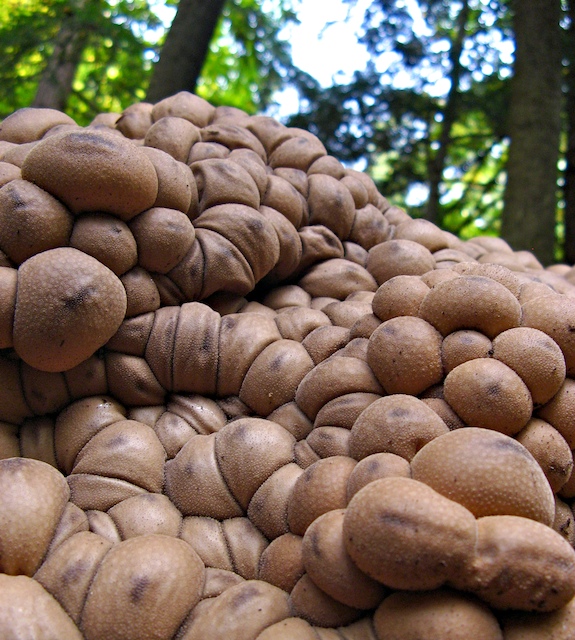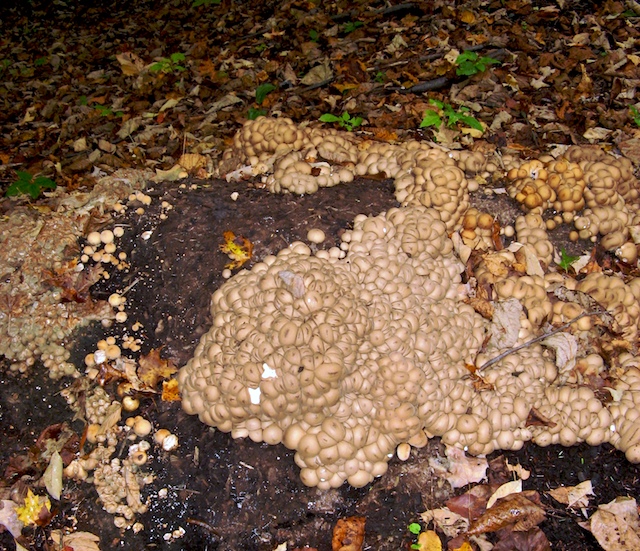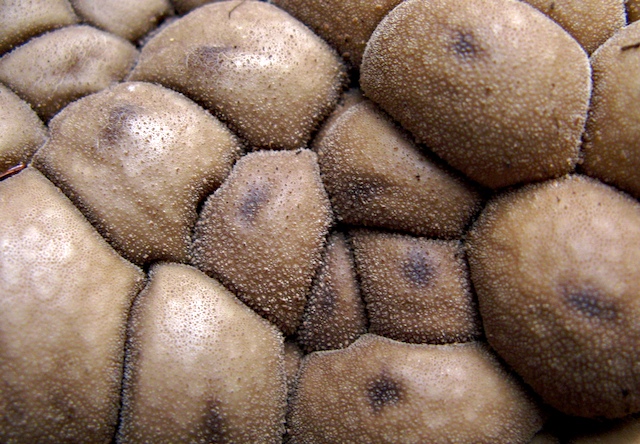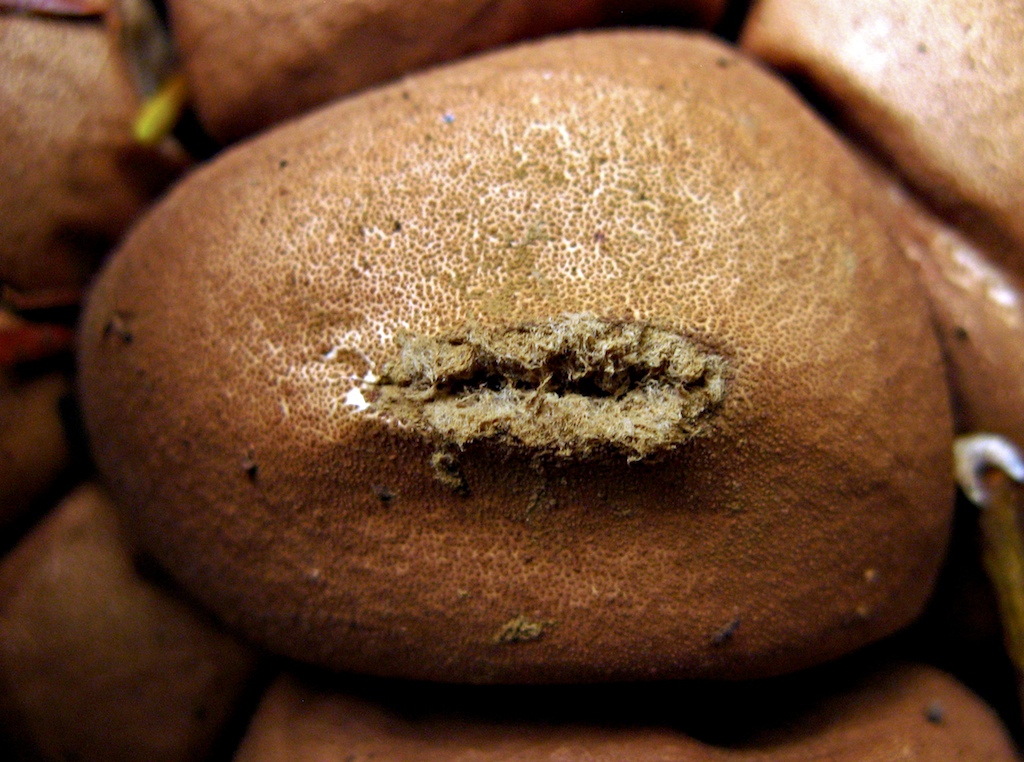Puffballs ate my mulch
I’m not a very good gardener, despite good intentions. That’s why I have a pile of bark mulch that I never got around to spreading. At first it stood as a testament to my indolence; a reminder of horticultural shame as I passed by every morning and evening. How I despised it! But then it started growing puffballs.
Not just a couple of little puffballs either, but a massive, tumorous pile of them. A burgeoning puffball eruption! At night I could hear them muttering at each other (hey, heeyy, heeeyyy) as they shouldered themselves some room to grow. They really like my mulch.

Although collectively huge, these aren’t giant puffballs, they’re just “ordinary” puffballs. They don’t need water to disperse their spores like normal mushrooms; their spores get puffed out by deer hooves, drops of rain, scampering chipmunks, and the stomping shoes of certain children I know.
Puffballs are funny fungi that seek to offend. You might know them as members of the genus Lycoperdon (we’ll revisit this later). That name derives from the Greek words for wolf and fart. (Yes, I said fart on the internet. Sorry Mom). More about farts and the names of puffballs in many languages in the famous book, Mushrooms, Russia, and History, which you’ll want to read. I’ve never smelled a wolf fart, and I suspect one should generally avoid getting close to a farting wolf. One shouldn’t inhale the puffs of these puffballs either. To do so would be to risk lycoperdonosis (which I guess translates to wolf fart disease). There aren’t too many documented cases of this, it’s not like you can get it from a single stomp. But poofing some puffballs right into your nose will do it. A generous lungful of spores will result in breathing trouble, fever, and pulmonary damage. These symptoms can take months to clear, but as far as I can tell, they appear to arise from hypersensitivity and inflammation rather than fungal growth in the lungs. You will not be eaten by puffballs as if you were a big mulch pile.
Lycoperdon might be one of the coolest fungus names ever (cast your vote here!). But alas, my mulch puffballs are no longer Lycoperdons. You see, mycology is in the midst of the biggest revolution since Elias Fries sorted and named everything (C.H. Persoon was a help too, particularly amongst the puffballs). We’re using genetic information to sort things out now. These puffballs turn out to be genetically distant cousins of the true Lycoperdon species (like L. perlatum). They’re morphologically different too, and they like to eat wood more than other Lycoperdons. Different enough that Kreisel and Krüger have moved our mulch puffballs into the genus Morganella, where they can hang out with closer kin. So now we must learn to call these wood-eating, often pear-shaped puffballs Morganella pyriformis.
Now a word for you, you mulch people. You are better gardeners than me; I admire your lovely, tidy gardens, your muddy knees. You are thinking about writing to me, aren’t you? To ask how to kill the puffballs that are eating your mulch? So it’s back to basics then: What’s mulch for? A cover for your lovely rich soil that you have worked so hard to build. It cuts down on erosion, suppresses weeds, maintains moisture, and… and what? Provides nutrients for your pretty little plants as it breaks down to form humus. So don’t ask me how to get rid of puffballs. They are breaking down your mulch (a euphemism for eating it), but in the process they are feeding your plants and building your soil. The puffballs are your friends. If you really don’t want your mulch to break down, try plastic. But unsubscribe me from your fan club.
To sum up: Coolest name ever, but this lignicolous species has been exiled from the wolf farts. Snorting them leads to lycoperdonosis, which I suppose is a misnomer if we’re Morganella now. Stomping is fun; hold your breath. Mulch people: love thy mushrooms. Puffballs, eat your mulch.
- Henriksen NT. 1976. Lycoperdonosis. Acta Paediatr Scand. 65(5):643-645. [PubMed Abstract]
- Krüger, D, Kreisel H. 2003. Proposing Morganella subgen. Apioperdon subgen. nov. for the puffball Lycoperdon pyriforme. Mycotaxon 86: 169-177.
- Krüger D, Binder M, Fischer M, Kreisel H. 2001. The Lycoperdales: A molecular approach to the systematics of some gasteroid mushrooms. Mycologia 93(5): 947-957.
- Munson EL, Panko DM, Fink JG. 1997. Lycoperdonosis: Report of two cases and discussion of the disease. Clinical Microbiology Newsletter 19(3): 17-21 . doi:10.1016/S0196-4399(97)89413-5
- Strand RD, Neuhauser EBD, Sornberger CF. 1967. Lycoperdonosis. New England Journal of Medicine 277: 89-91.
- Taft TA, Cardillo RC et al. 1994. Respiratory illness associated with inhalation of mushroom spores — Wisconsin, 1994. MMWR 43 (29): 525-526.
- Tom Volk’s Fungus of the Month for November 2001: Lycoperdon pyriforme, the wolf-fart puffball.
- Valentina Pavlovna Wasson and R. Gordon Wasson. 1957. Mushrooms, Russia and History. NY: Pantheon Books. [in this scanned version, look for puffballs in Vol. 1, beginning on page 97]
Note: The few published articles on lycoperdonosis don’t identify the causal puffballs to species. They might well be either true Lycoperdons like Lycoperdon perlatum, or Morganella pyriformis. The former has spiky little spores; the latter smooth. I wonder whether spikiness has something to do with the resulting disease; whether surface antigens are more the culprits; or whether the problem is simply the body’s response to a massive insult of small particles?
Another note: Strand et al’s early case of lycoperdonosis occurred just up the road from me in Cortland, NY, after a boy inhaled puffball spores to staunch a nosebleed. The distinguished doctors recommend that “In the interest of preventative medicine it is suggested that the puffballs be gathered while young and, thinly sliced, sauteed in butter with a touch of garlic and a pinch of thyme.”







I would never ask you how to rid my garden of mushrooms.
I’m so glad to hear that somebody else has a love of puff balls! I will forever think of wolf farts and your wonderful sense of humor as I stomp them in the future!!
Hmmm. So what WOULD happen if you inhaled puffball “smoke”? Would puffballs sprout in your lungs? I did hear once about how an inhaled tomato seed actually did sprout inside someone’s lungs. Very weird!
Last summer my tomato seeds sprouted while still inside their tomatoes. Weird. Puffball spores apparently don’t germinate very readily (?). But what happens is that your lungs mount an immune response to each little one, and you don’t feel so great while all this is going on.
It is vaguely reassuring to me that there is (was) a Latin word for farts. And that it is applied to puffballs makes an odd yet perfect kind of sense. I like it…
I can’t tell which is more finely honed, your sense of humor or your teaching ability. I’ll take either or both!
One comment: The august tomes by the Wassons (Mushrooms, Russia, and History) that you refer to are available on line. See http://www.newalexandria.org/archive/ That’s a good thing, given the scarcity of the printed version and its price.
Shucks, thanks Elio. Thanks also for the link, which I’ll tip in to the story now.
Also in Catalan are they called ‘wolf farts’ (‘pets de llop’; ‘pet’ = fart, and ‘llop’ = ‘wolf’).
Congratulations on this blog, of which I knew from Elio’s “Small things…”
Someone at Mann Library tipped me off to your blog. Too cool! This post reminded me of a mass of fungi I saw this summer growing out of pine bark/white pine needle mulch. Photo: http://farm3.static.flickr.com/2532/4117986627_7c0c1626b6_b.jpg
Welcome, Michael. Those folks at Mann are unusually cool, aren’t they? Your orange fungi are jack o’lantern mushrooms, which are also unusually cool but more poisonous than your typical librarian. We’ve got more about them here.
I came here via you fungus planet lecture on cybertower, which my 14 yr.old daughter and I watched together. It kept even her interest. Thanks!
There have been several different types of fungi growing on mulch piles around here the past few years, but no large patches of puffballs. Can you eat these brown ones? I grew up eating only the big white solitary kind routinely found in pastures.
Welcome Deborah, glad you and your daughter liked my lecture.
There are a bunch of different, small puffballs, and you’d best know which ones you’ve got before you eat them. To distinguish them from the poisonous pigskin puffball (Scleroderma), for example. These ones–Morganella pyriformis–yes, you can eat them. If you read all the way down to the very bottom of the references section, you’ll even find a sort of recipe. I didn’t eat them though; I’m afraid I’m not much of a puffball fan.
Oh man, this article cracked me up! *applauds the author* Definitely posting a link to this on Facebook. 🙂 I was just Googling around on my lunch hour trying to find out what kind of mushrooms I have popping up in the mulch of one of my flower beds. I don’t have puffballs (mine are really, really tiny), but I suppose I shouldn’t try to get rid of them, eh?